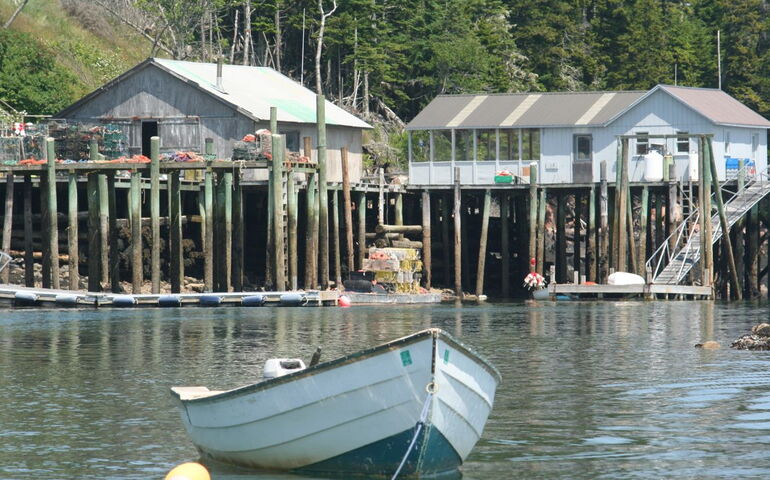Seafood roadmap looks to grow industry by 10%, add 1,000 jobs by 2030
 File photo / Laurie Schreiber
Maine’s seafood sector, including downstream contributors, in 2019 contributed over $3.2 billion to the state economy and supported over 33,300 jobs.
File photo / Laurie Schreiber
Maine’s seafood sector, including downstream contributors, in 2019 contributed over $3.2 billion to the state economy and supported over 33,300 jobs.
Maine’s seafood industry is looking to grow its revenues by 10% and add 1,000 jobs by 2030.
The Seafood Economic Accelerator for Maine, or SEA Maine, on Friday morning unveiled an economic development roadmap for achieving that growth. The planning was an industry-led effort was funded by the U.S. Economic Development Administration with support from Maine Technology Institute and FocusMaine.
“Maine’s future depends on continued growth of the marine living resource sector,” said Curt Brown of Ready Seafood, co-chair of the SEA Maine steering committee.
The sector includes fishing, lobstering, aquaculture, life sciences, and value-added processing as well as supply chain elements such as shipping and logistics.
Other goals of the plan are to:
- Increase sector-wide financial investments to support infrastructure, available capital, market expansion, and research and development;
- Maintain and expand Maine’s working waterfront access and the capacity of working waterfront communities to support infrastructure and businesses; and
- Enhance the ability of the sector to respond to challenges and opportunities resulting from climate change and demographic shifts.
Projects emerging from the plan include the creation of a Maine Seafood Promotional Council funded by the Maine Department of Economic and Community Development, which is in the process of being created, according to a news release. The council is expected to enhance the Maine seafood brand, bring Maine’s seafood to new market and strengthen Maine’s overall food economy.
SEA Maine intends to implement additional projects outlined in the plan in the coming years.
Wide-ranging perspectives, goals
Participants in the development of the plan included the Maine Coast Fishermen’s Association, Maine Aquaculture Association, Department of Marine Resources, Department of Economic and Community Development, Maine Lobstermen’s Association and the University of Maine. More than 30 businesses from Aroostook County to southern Maine participated in interviews.
Workforce attraction and diversification are identified as key elements. Goals for workforce development include:
- Improving employer access to trained workers,
- Making training accessible to potential employees from all backgrounds,
- Developing sector-specific skill-building and credentialed education programs through the state’s educational institutions,
- Developing recruitment campaigns to highlight the range of career opportunities in the sector,
- Recruiting diverse talent from across Maine and beyond.
SEA Maine produced seven workforce attraction videos on subjects like innovation, science, logistics and transportation.
The plan describes the advantages of the Gulf of Maine for the seafood economy, including cold water, a complex geomorphology of deep basins and shallow banks and biologically productive marine ecosystems.
However, Maine’s long coastline, with many peninsulas and remote communities, creates infrastructure challenges, says the plan, which identifies the creation of robust infrastructure as a key priority.
The roadmap also outlines the diversity of Maine’s seafood economy. It includes lobster, fish, shellfish and seaweed, both farmed and wild-caught, with alterations of some of the naturally occurring species over the years. Resources are harvested for food and for non-food products such as biostimulants, natural fertilizers, and health, beauty, nutritional and medicinal products.
The plan is based on commissioned reports, with data and input collected from industry stakeholders and external reports such as Maine’s Economic Development Strategy 2020-2029, Maine Won’t Wait and the Maine Aquaculture Roadmap.
"Maine is continuing to lead through innovation in our heritage industries, including the marine economy," said Heather Johnson, commissioner of the Department of Economic and Community Development. "SEA Maine's work on this roadmap will help guide workforce development efforts and diversification of the marine economy to foster growth and sustainability."
According to a SEA Maine report issued last year, Maine’s seafood sector as a whole, including downstream contributors, in 2019 contributed over $3.2 billion in total economic output to the state economy. The sector also supported over 33,300 jobs, including 23,846 in sector industries and 7,300 additional jobs supported by other indirect and induced multiplier effects.
In addition, Maine’s seafood also contributes to the state’s $8 billion tourism industry, according to the plan.
For more information, click here.










0 Comments